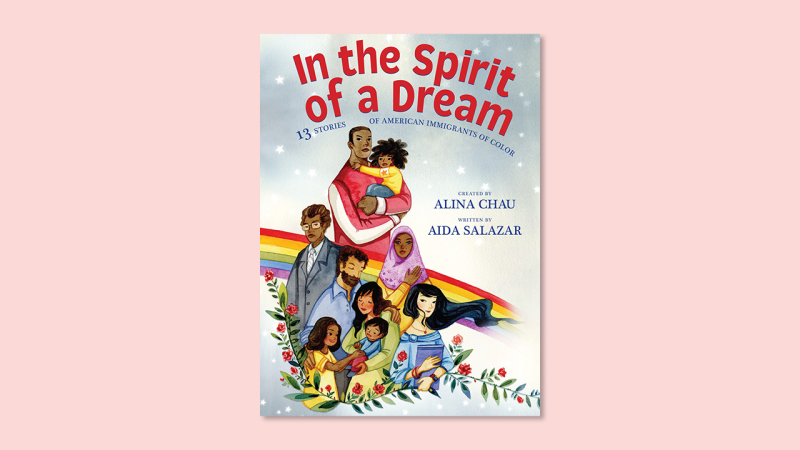"We set across continents, oceans, and borders, to find a place where we have been told our dreams can be made..."
In the Spirit of a Dream honors and celebrates American immigrants of color by highlighting 13 biographies written in poems with accompanying illustrations. Award-winning author and arts activist Aida Salzar speaks with us about this new picture book, which was developed with creator Alina Chau.
Read the interview below:

In the Spirit of a Dream highlights 13 notable American immigrants of color. Were there any profiles that were particularly special for you to write?
That is always a tough question. It’s like asking me which of my books or which of my children I love best. When we asked my mother which of her seven children she loved best, she would simply say, “My heart is big enough to hold all of you equally.” I completely agree!
This said, it was important to me that the range of the immigrant experience was depicted in this collection. From famous political leaders and artists, to not-so-famous community trailblazers, to those whose work often goes unnoticed because they are in this country without authorization or because they are parents and labor in the fields, in the sweatshops or in their mom-and-pop shops in the flea markets. We wanted to make sure that despite what immigrants do, it is understood that they are valued. It is their resilience, their joy, their human spirit that makes them notable in this country.
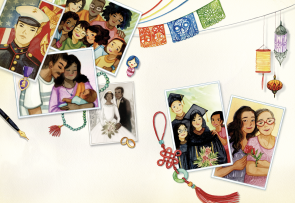
Why did you choose to write about your subjects in the form of poetry? What can poetry convey that other forms of writing cannot?
As the sole writer on the project with thirteen different illustrators, I focused on making a heart connection with the immigrants featured as I researched and spent time with their life stories. I looked for the humanity within each person, outside of what they did, or do, in the world, for the way their spirit dreamt and dreams. Making this heart connection supports one of the most fundamental things about writing poetry for me. It is what Billy Collins said, “Poetry is the history of the human heart.” Poetry lives within the realm of emotion. It is that which cannot be seen but wholly felt. This is the mantra and the model which guides how I approach a poem. For the execution, I called upon my craft as a poet and the unique tools of poetry – imagery, metaphor, figurative language, rhythm, etc. – to deliver a poem that speaks to the spirit and dignity of each person and does so lyrically. I also drew on the essential poetic tool of economy. The poems needed to be short – one poem per person, per spread. The challenge to be brief also brings me to the place where poetry’s magic lives.
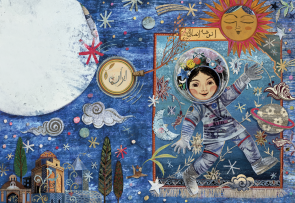
Can you tell us about your research process? What kind of preparation did you do before you wrote each poem?
I loved spending days on end falling down the rabbit hole of research for each of these powerful immigrants. I am nothing if not tenacious. I read anything my subject wrote or what was written about them in articles, books, scholarly journals, newspapers, etc. I spoke to people or looked at organizations that had been impacted by their work. But also, I’d met some of our figures like Conceicao Damasceno, Juana Gutierrez, The Undocupoets, and Candido Camero and had first person experience with them. I combed through videos, social media, listened to music, translated (using google translate) what I found in other languages.
In one particularly inspiring moment of research, I discovered that Ayub Khan Ommaya invented “The Ommaya Pump'' that helped those suffering from a disease called “hydrocephalus” drain excess fluid from their brains into their stomachs. My surprise came when I realized that Mr. Ommaya’s invention helped relieve my own father’s hydrocephalus and was keeping him alive and pain and symptom free. Though Ayub Khan Ommaya is no longer with us, it was a tearful moment of deep gratitude and universal alignment that I could write about him and his work.
I know that the creator of the anthology, Alina Chau, and our acquiring editor, Kait Feldmann, took a field trip to the Sriracha Factory in Los Angeles and did an in-factory tour. Alina illustrated David Tran, the founder of Sriracha, and it informed her beautiful art. I admit, I have been eating much more Sriracha since I learned about David’s story, too!
Overall, the intensive research I did helped me establish a connection with each person’s heart, their work, their vision, and with the worlds they built.
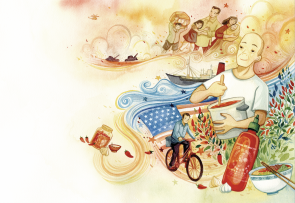
What were some of your favorite aspects of writing In the Spirit of a Dream? What were some of the challenges you faced?
The biggest challenge in writing the book was paring down the very long list of potential immigrants and deciding which to feature. We had a spreadsheet that cross referenced all of the different markers we had to meet to depict a very diverse, very wide range of immigrant experiences.
I know there was also a fun challenge for the art team in trying to decide who might be the best illustrator for each featured person. They had to consider art style, cultural connections, whether they were immigrants or descended from immigrants of color, and their availability in order to curate the amazing artists we have in the collection.
My favorite thing about this entire process has been knowing that though this book is far from complete, it is ultimately an ofrenda – an offering to American immigrants, who despite all of the adversity they face in coming, acclimating, and living in this country, have risen above the difficulty to thrive.
Another special part has been getting to know Alina Chau. While she is of Chinese/Indonesian descent and I am of Mexican descent, and our wider experiences are very different, our common experience of being immigrant artists with a vision for social justice is aligned in many ways.
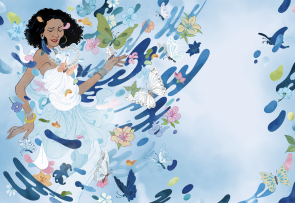
The American immigrant experience is so personal to many of us. While you were writing, were you thinking of similar stories that you and/or your family experienced?
Absolutely. I was thinking deeply about my mother and father who came to the United States in their twenties with four children in tow, searching for opportunity. They endured humiliation for not knowing or speaking English the right way, racism, bigotry, and discrimination. They created nothing extraordinary but a larger family and a stronger community because they lived lives in service to others. This was the reason why I wanted to include an ode to immigrant parents at the end of the book and why I dedicated the book to my parents. Like so many other parents, they were thinking about their children when they brought us here. I always cry when I see images of graduates dressed in their caps and gowns who go to their parents’ humble workplaces like the fields or the back of house at restaurants to thank and celebrate with them. It fills me with so much emotion because it represents the lucha, the struggle to live a dignified life, to get ourselves and our families ahead. I am so proud to be my parents’ daughter -- an immigrant myself and the daughter of immigrants. I am grateful that they made the journey and that through this book, I have the opportunity to share the beauty of this lens with children.

How did the title “In the Spirit of a Dream” come about?
One of the things I need in order to write a book in verse is to center it on a metaphor or a theme that is in some way poetic. I threw out several ideas and this one made the most sense.
Our book was created to push back against the anti-immigrant, racist and xenophobic rhetoric alive in the country at this time. The book’s title had to speak to the “American dream,” which is certainly plagued with problems. The American dream doesn’t come true for many because there are so many challenges to living in the United States when you don’t know the language, may or may not be undocumented, and face discrimination in many parts of the country simply for being foreign. “The American dream” also disregards the First Nations of this country, who suffered genocide and whose lands were stolen, and the enslaved people who endured a long history of brutality and on whose exploited labor much of this country was built. For them, this idea is not a dream but a nightmare. At the same time, it is impossible to ignore the impact of coming to the United States for a better life has done for people of marginalized communities and from third world countries. As I mentioned, this is the reason why I am here. This is what we are trying to get at. Not the dream itself but the human spirit that strives to be well and to live a dignified and joyful life.
-----
About Aida Salazar
Aida Salazar is an award-winning author and arts activist whose writings for adults and children explore issues of identity and social justice. She is the author of the middle-grade verse novels The Moon Within (International Latino Book Award Winner), Land of the Cranes, and the biography picture book Jovita Wore Pants: The Story of a Revolutionary Fighter. With Yamile Saied Méndez, she is slated to coedit Calling the Moon, a middle-grade anthology on menstruation by writers of color. She is a founding member of Las Musas, a Latinx kidlit debut author collective. Her short story "By the Light of the Moon" was adapted into a ballet production by the Sonoma Conservatory of Dance and is the first Xicana-themed ballet in history. She lives with her family of artists in a teal house in Oakland, California.
About In the Spirit of a Dream
Celebratory, triumphant, and inspiring, In the Spirit of a Dream is a tribute to American immigrants of color, written and illustrated by 14 first- and second-generation immigrant artists. Featuring 13 biographies, from world-famous to local heroes,, In the Spirit of a Dream is told in poems by Aida Salazar with artwork by Alina Chau, Bianca Diaz, Dion MBD, Fahmida Azim, Gaby D'Alessandro, Jose Ramirez, Ken Daley, Nicole Xu, Paulo D. Campos, Rahele Jomepour Bell, Tracy Guiteau, Vanessa Flores, and Yasmin Imamura.

